International travellers visiting Tokyo who dread the two-hour commute between Narita International Airport and the city centre will soon heave a sigh of relief.
By October 21, Haneda Airport will complete a major expansion programme that was designed to transform the infrastructure as Japan’s second global hub. The reinvigorated facility will include a fourth runway, a new international air terminal, an apron area and a new international cargo terminal.
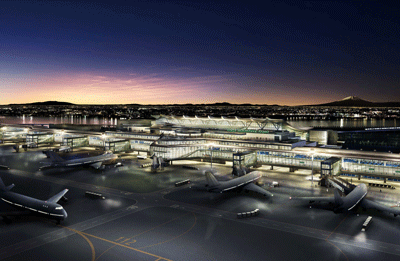
This national landmark was the main international gateway into the Japanese capital between 1951 and 1978 until it surrendered its crown to Narita International Airport and became primarily the air hub for domestic flights in and out of Tokyo.
Located only 18km – about 30 minutes’ drive – from downtown Tokyo, its proximity to the capital’s financial and commercial districts makes Haneda Airport an ideal point of disembarkation for international travellers.
To date, the airport accepts limited “charter flights” from overseas, mostly to and from key Korean and Chinese cities.
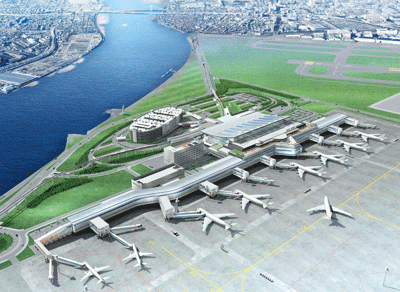
The Japanese government approved in 2005 the expansion of Haneda Airport under the “private financial initiative”, which means the private sector – in particular the specially created “special purpose companies” (SPCs) – was tasked to build most of the project, except the airport runway.
When completed, the airport will shift to a 24-hour operation and the new international air terminal is estimated to handle 30,000 slots – including landings and take offs – annually during daytime and another 30,000 slots a year during night-time services.
According to Yoichi Hirai, director of corporate planning at Tokyo International Air Terminal (TIAT), the Japanese authorities are already mulling over the idea of increasing the volume of daytime flights to 60,000 slots a year in several years’ time. This would double the amount from the planned 40 landings and 40 take-offs a day to 80 each.
“The new international air terminal at Haneda Airport is expected to handle approximately seven million passengers a year,” he says.
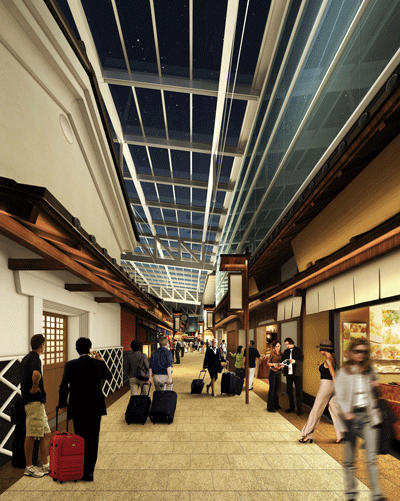
TIAT is the SPC given the right to build, manage and operate the new international air terminal.
TIAT is a consortium of 13 companies with Japan Airport Terminal, which operates the domestic terminals at Haneda Airport, as the biggest stockholder.
The company is now building the five-storey, 154,000sqm passenger terminal as well as the six-level, 67,000sqm public car park for 2,300 vehicles at a total cost of JPY110 billion (about US$1.2 billion).
“We have 10 boarding gates, two of them have dual-type parking stands,” Hirai says. “One of the gates is equipped to accommodate an Airbus A380.”
Arrival and departure areas are located on the second and third floors respectively. They have been designed for passengers to walk through the airport from the landside entrance to the boarding gate without having to go up and down escalators.
“We call it a ‘single level flow line with direct forward access’ so that departing passengers will go through check-in, immigration – all the way to the boarding gate without changing floors. It will also be the same way for arriving passengers who will pass through the gate, immigration and baggage claim area without having to move up or down several floors.”
Hirai adds: “We want to make the terminal easy to use. Many passengers already find many airports very confusing to navigate.”
What’s more, the facilities are designed to be ergonomically friendly. The terminal claims to have the world’s first flat passenger boarding bridge and elevators are equipped with emergency buttons for visual- and hearing-impaired passengers. Furthermore, standardisation of wheelchair codes is planned with rail and airline operators to facilitate movement.
To help passengers and other airport users to find their way in the new international air terminal, a passenger information service is available in four languages.
Groups checking in at the airport have their own dedicated check-in counters on the ground floor.
The new international air terminal at Haneda Airport will offer a free shuttle bus service to ferry passengers to and from the two existing domestic terminals. The service will run every 20 minutes. The whole journey between terminals takes about eight to 10 minutes.
The airport also has a convenient access to Tokyo’s train network with the Tokyo Monorail and the Keikyu lines just at its doorsteps.
Plans are being made for both companies to provide rail service between the international terminal and domestic terminals 1 and 2.
This service, which will entail a three-minute ride,will be free of charge for transit passengers.
Meanwhile, there will be an airside bus for transit passengers with short connection times.
Airline lounges equipped with cat nap corners and shower facilities will be located on the fourth floor airside, where the food court will also be located.
Arrival lounges with day rooms and shower facilities will also be made available for use of inbound passengers on the second floor.
While Duty Free and F&B outlets can be found at the restricted areas of the new terminal, a whole new world of dining and shopping experience awaits all visitors to Tokyo’s new international hub.
The fourth floor landside will feature a shopping mall with retail and F&B outlets. Its two architectural highlights will include a Sky Garden and an Edo-Koji area.
The fifth floor will contain more commercial spaces. There will be a planetarium and a so-called “fantasy zone” recreating the world of Japanese anime.
“We have what we call the ‘Made in Japan Haneda Only One’ concept for the fourth and fifth floors,” Hirai explains.
“We want to showcase the country’s different architectural styles and cultural elements from traditional Japanese to contemporary manga.”
Hirai says the construction of the terminal has been very smooth these past two years even amidst the global financial crisis that began in September 2008.
“Fortunately, we didn’t experience any major typhoons either, that could have stalled the project,” he adds, saying TIAT expects the terminal to be completed on schedule and within budget.
TIAT is optimistic about Haneda Airport’s prospects as Japan’s second air hub.
“We are opening at just the right moment, when the global recession is receding and air passenger numbers are expected to go right up,” Hirai says.
Jockeying for position
As Haneda Airport opens up to more overseas flights, competition among airlines is heating up for coveted landing rights Japan Airlines (JAL) recently received the green signal from the Japanese government for its planned new routes as well as increased frequency of existing flights to Haneda Airport.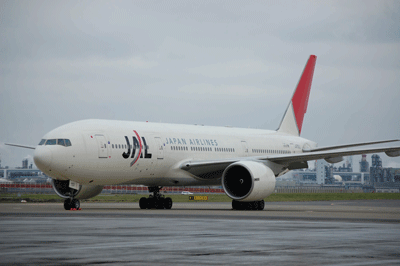 In early June, the carrier got the approval to introduce new international services from Haneda Airport such as Honolulu and San Francisco in the US, Paris, France, Bangkok, Thailand and the emerging airport at Songshan in Taipei.
These new routes are expected to fly seven times a week except for Songshan, which is earmarked for 14 weekly flights.
JAL expects to come out with the schedule of these new flights by the end of June.
“The long-haul flights to the US and Europe are scheduled for the midnight services as there are no restrictions on the routings during night flights from Haneda,” says Eiji Takemura, JAL director of corporate planning, adding that the carrier has also asked to fly between Haneda and Singapore.
Besides the new routes, JAL also got the nod for increased flight frequency on its existing routes from Haneda, such as Gimpo Seoul, Beijing, Hongqiao (Shanghai) and Hongkong.
“As the airport is very near to the city centre, we are thinking of shortening the check-in closing time by 30 minutes Haneda,” Takemura says.
“Also, we are planning to provide a shuttle bus service to ferry passengers between Domestic Terminal 1 and the new international air terminal.”
In early June, the carrier got the approval to introduce new international services from Haneda Airport such as Honolulu and San Francisco in the US, Paris, France, Bangkok, Thailand and the emerging airport at Songshan in Taipei.
These new routes are expected to fly seven times a week except for Songshan, which is earmarked for 14 weekly flights.
JAL expects to come out with the schedule of these new flights by the end of June.
“The long-haul flights to the US and Europe are scheduled for the midnight services as there are no restrictions on the routings during night flights from Haneda,” says Eiji Takemura, JAL director of corporate planning, adding that the carrier has also asked to fly between Haneda and Singapore.
Besides the new routes, JAL also got the nod for increased flight frequency on its existing routes from Haneda, such as Gimpo Seoul, Beijing, Hongqiao (Shanghai) and Hongkong.
“As the airport is very near to the city centre, we are thinking of shortening the check-in closing time by 30 minutes Haneda,” Takemura says.
“Also, we are planning to provide a shuttle bus service to ferry passengers between Domestic Terminal 1 and the new international air terminal.”
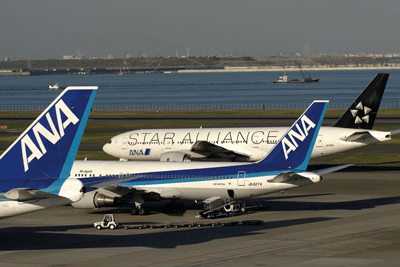 Rival Japanese carrier All Nippon Airways (ANA), meanwhile, is eyeing increased flights to Gimpo in Seoul, Beijing and Hongqiao in Shanghai.
The airline expects to announce new routes from Haneda Airport to other Asian and US cities on the west coast by this summer.
“Haneda will catch demand from ANA’s domestic connection, while Narita will remain as a hub using its connectivity with other airlines,” says ANA president and CEO Shinichiro Ito.
He notes that Narita and Haneda airports will complement each other. “Even if Haneda opens as an international airport, this is not enough to cover all the network we currently have in Narita,” Ito says.
“Therefore, we will use both airports as dual hubs for the Tokyo metropolitan area.”
For several months now, airlines outside Japan similarly have been applying for the coveted landing rights at Haneda Airport.
With the recent “open skies” agreement between the US and Japan, American carriers have been vying for the four prized slots at Haneda. with Delta Airlines, American Airlines and Hawaiian Airlines being tipped to share the slots.
Singapore Airlines (SIA) is the first one to get its slot as the sole Singapore carrier allowed to fly between Changi Airport and Haneda Airport. The airline has been granted the rights to fly a twice-daily flight to Haneda for a total of 14 weekly flights starting in October.
SIA’s main Asian competitor Cathay Pacific is also seeking similar rights from its home base, eyeing a twice-daily service into Haneda from Chek Lap Kok Hong Kong International Airport.
Yoichi Hirai, director of corporate planning at Tokyo Air Terminal Corporation, the company that will run and manage the new international air terminal at Haneda, says the slots for other Asian and European destinations are yet to be allocated.
“Right now, we have the bilateral air agreements between Japan and other countries for routes to and from Haneda. We are still waiting to see which airlines will get specific routes,” he adds.
But as Alex McWhirter of Business Traveller UK wrote in a news story at www.businesstraveller.com in March, European carriers such as British Airways, Air France and KLM may face a problem with curfew restrictions at their home bases even if they are keen to serve Haneda.
Long-haul flights to and from Haneda Airport are to be scheduled only for night services between 2300 and 0600.
“That does not present too much of a problem when flying to Singapore. But if BA were to schedule a flight leaving Haneda at 2300 (a time which would enable a full day’s work for business people) it would fall foul of the Heathrow curfew,” McWhirter said. “It would be a similar situation with KLM at Schiphol and while Air France might manage an early arrival into CDG, it would be at a time when the rest of Paris is shut down.”
“The solution for an early arrival in Europe would be to depart Haneda in the middle of the night, say at 0300, but who would want to board at such an unsocial hour knowing they faced a 13 hour flight?”
It remains to be seen whether these restrictions on long-haul flights from Haneda will be changed.
But for now, Haneda Airport is gearing up to step into the spotlight as Japan second major air hub.
Rival Japanese carrier All Nippon Airways (ANA), meanwhile, is eyeing increased flights to Gimpo in Seoul, Beijing and Hongqiao in Shanghai.
The airline expects to announce new routes from Haneda Airport to other Asian and US cities on the west coast by this summer.
“Haneda will catch demand from ANA’s domestic connection, while Narita will remain as a hub using its connectivity with other airlines,” says ANA president and CEO Shinichiro Ito.
He notes that Narita and Haneda airports will complement each other. “Even if Haneda opens as an international airport, this is not enough to cover all the network we currently have in Narita,” Ito says.
“Therefore, we will use both airports as dual hubs for the Tokyo metropolitan area.”
For several months now, airlines outside Japan similarly have been applying for the coveted landing rights at Haneda Airport.
With the recent “open skies” agreement between the US and Japan, American carriers have been vying for the four prized slots at Haneda. with Delta Airlines, American Airlines and Hawaiian Airlines being tipped to share the slots.
Singapore Airlines (SIA) is the first one to get its slot as the sole Singapore carrier allowed to fly between Changi Airport and Haneda Airport. The airline has been granted the rights to fly a twice-daily flight to Haneda for a total of 14 weekly flights starting in October.
SIA’s main Asian competitor Cathay Pacific is also seeking similar rights from its home base, eyeing a twice-daily service into Haneda from Chek Lap Kok Hong Kong International Airport.
Yoichi Hirai, director of corporate planning at Tokyo Air Terminal Corporation, the company that will run and manage the new international air terminal at Haneda, says the slots for other Asian and European destinations are yet to be allocated.
“Right now, we have the bilateral air agreements between Japan and other countries for routes to and from Haneda. We are still waiting to see which airlines will get specific routes,” he adds.
But as Alex McWhirter of Business Traveller UK wrote in a news story at www.businesstraveller.com in March, European carriers such as British Airways, Air France and KLM may face a problem with curfew restrictions at their home bases even if they are keen to serve Haneda.
Long-haul flights to and from Haneda Airport are to be scheduled only for night services between 2300 and 0600.
“That does not present too much of a problem when flying to Singapore. But if BA were to schedule a flight leaving Haneda at 2300 (a time which would enable a full day’s work for business people) it would fall foul of the Heathrow curfew,” McWhirter said. “It would be a similar situation with KLM at Schiphol and while Air France might manage an early arrival into CDG, it would be at a time when the rest of Paris is shut down.”
“The solution for an early arrival in Europe would be to depart Haneda in the middle of the night, say at 0300, but who would want to board at such an unsocial hour knowing they faced a 13 hour flight?”
It remains to be seen whether these restrictions on long-haul flights from Haneda will be changed.
But for now, Haneda Airport is gearing up to step into the spotlight as Japan second major air hub.
TOKYO’S GRACE
Knowing the right etiquette in foreign lands makes business a lot easier. Felicity Cousins explores Tokyo and some Japanese dos and don’ts
The traffic lights are green but there are no cars in sight. I consider making a dash for it but as I look to my left and right, I see everyone is frozen to the spot. Jay-walking doesn’t happen in Tokyo. As the red light glows, everyone comes to life and continues their business. I’m trying to find the Mitsukoshi store but I am lost. I ask several people the way, and although they try hard to be helpful, they are pretty useless with my paper map – they can’t even find where we are, let alone where I am going. Emi Takei, director of communications at the Shangri-La hotel in Tokyo, says: “Map literacy isn’t very good here. It is easier to show an electronic map or type the address into your mobile phone.” Getting lost is fine if you have time to explore, but for business travellers it’s best not to be late. The Japanese are very punctual, and the trains run like clockwork so there is no excuse. “If you are going to be even five minutes late, you should ring ahead to let your contact know,” Takei says. If it is your first meeting with a Japanese contact a gift is not necessary, but if you are building a relationship with a Japanese colleague or client and you haven’t seen them for a while, it is polite to bring one. Mark Kobayashi, director of public relations for the Peninsula Hotel Tokyo, explains: “It’s a gift-giving culture so try to bring something local to where you are from – maybe British tea or chocolate. Make sure your gift is wrapped well, preferably from the store you bought it in, and if there is any information about the gift, such as a brochure or business card, then bring that too. Japanese people often put the gift in their office with the information next to it for people to read. Try to select something that can be shared with colleagues.” As most visitors are aware, bowing is a sign of respect in Japan and the deeper someone bows, the more respect they are giving the person before them. Takei says: “Shaking hands is not our custom. When US president Barack Obama came to Japan, he bowed very deeply to our emperor and for us it was a nice gesture. You should bow when you meet your client – and the hierarchy defines how low and slowly you bow.” Another way to make a good first impression is to hand over your business card in the correct way as soon as you are introduced. Kobayashi says: “Business card exchange is important because in Japan, people associate the person with the company.” Offer your card with both hands, holding it with your thumb and forefinger at the corners – make sure it is facing the right way for the recipient to read. You can place it on top of your business-card holder too, as if offering it on a plate. When you receive a card it is polite to make a comment to show you are interested – for example, you may notice the address of the office and say: “Ah yes, Ginza, that is the shopping district.” Kobayashi says: “It would be seen as rude if you did not get your card out until the end of the meeting and said, ‘Sorry, I forgot to give you this.’ Business cards are very important and if you have one side printed in Japanese then this is a great plus. Anyone doing business in Japan should make this a priority as it really shows you are serious.” Takei adds: “Without a business card exchange there is no meeting.” If you have managed to secure a meeting, then note that the most important people will sit in the middle of the table, furthest from the door. But while these formal meetings are essential, in Japan, the real business deals are cemented after hours. Takei says: “Drinking and eating is a big part of business and often the discussion is done in a restaurant or bar. If you are taking a Japanese client out then don’t take them to a Japanese restaurant as the Japanese feel they know better ones than a foreigner. It is common to take them to a high-end hotel that serves Western food.” The Japanese will entertain foreign guests in a more casual restaurant or bar, often followed by a session of karaoke, in which you should try to participate. Kobayashi says. “You are not pressured to drink but if you do not like socialising after office hours, this will cause a problem here because a lot of the business relationship is built away from the office. Before you can do any business, sign a contract or talk money, you have to establish a relationship with your contact. Once you do this things will fall into place.” He adds: “A lot of people think: ‘I have given my presentation and explained my points so things should move forward,’ but this is nothing without a relationship. You have to take the next step and ask the client out for dinner or drinks and get to know them. It’s a chance to let your hair down.” There’s no need to worry if you embarrass yourself because what happens out of the office stays out of the office. The next day, people won’t refer to the evening except to thank you for arranging it. I keep walking, past restaurants with plastic replicas of their dishes in the windows, until at last I arrive at the Mitsukoshi store. All the shoppers are stopping at the entrance to slide their umbrellas into a metal machine. When they remove them, they are covered in plastic to stop them dripping on the floor. All these things are foreign to me, but in Tokyo they make perfect sense. Cultural Tips In Japan, the New Year is very important. If you have Japanese clients, you should send a greeting card. They will appreciate it. Japan is not a tipping culture. Never leave your chopsticks upright in your food or pour your own drink at a meal. Your neighbour should pour yours and vice versa. Avoid asking direct yes or no questions or expressing strong emotion or direct opinion. Do not blow your nose in public - however, sniffing is permissible.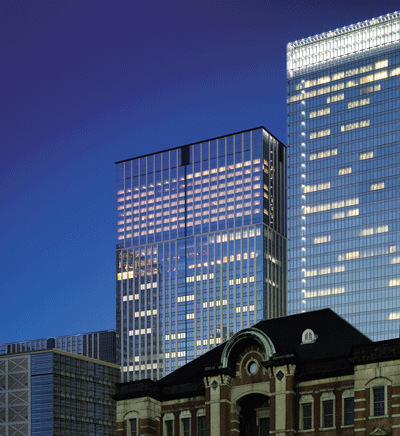
Hotel Check Tokyo
Shangri-La HotelWhat’s it like? The newest international deluxe hotel in the Japanese capital, the Shangri-La Hotel, Tokyo is unashamedly aimed at the upmarket traveller. Located close to Tokyo’s most important business and nightlife districts – Nihonbashi and Ginza – the Shangri-La’s location is hard to beat. Accessibility to rail and airport links is also one of the hotel’s strong points.
Where is it? The Shangri-La is perched on the top 11 floors of Marunouchi Trust Tower Main building, in the Chiyoda district of Tokyo. The Imperial Palace area, Nihonbashi and Ginza are all within a 10-15 minute walk. Given Tokyo’s sprawling character, the fact that the hotel is adjacent to Tokyo Station, where direct Shinkansen (Bullet Train) services connect to most areas of Japan and to local city rail and metro services, makes this location even more advantageous for business travellers navigating the metropolis or heading off to other cities in Japan.
Room facilities A large LCD TV shows a whole host of international satellite and cable channels as well as in-house movie channels and a DVD player. There are coffee- and tea-making facilities and a well stocked mini-bar.
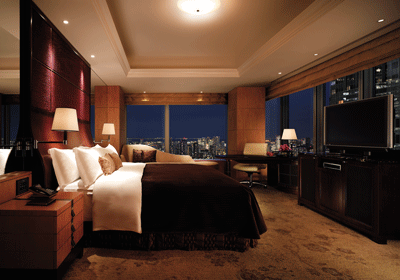
There is an extremely spacious executive writing desk for those who need to catch up on work, with easy to manage power and cable sockets and phones with IDD connections. Normally this would be scarcely worth pointing out, but business travellers to Japan need to remember that not all non-Japanese personal mobile phone systems will work in Japan. Bathroom and bed amenities are of an expectedly high Shangri-La quality, although it may be worth taking advantage of the pillow menu if you have allergies or are just plain fussy. The bed linen is a luxurious 300-threadcount cotton.
Business and meeting facilities The hotel’s modest but state-of-the-art meeting facilities are located on the 27th level of the hotel. There is a 366sqm Shangri-La Ballroom, which fits 273 people theatre style. Nearby are three smaller Conway rooms, which can be combined in various configurations. These could serve as break-out rooms or as standalone spaces for groups up to several dozen. There is a well equipped Business Centre which also has a small boardroom for meetings of up to eight people. There are also three private internet booths. The centre provides secretarial, translation and courier services.
Restaurants and bars In such a culinary mecca as Tokyo, any hotel needs to offer exceptional choice. The Shangri-La concentrates on two high-end outlets, the first Japanese and the other Italian. There is also a very busy lobby lounge. On the 28th floor, is the Italian restaurant Piacere, whose Italian chef brings all the flavours and elegance of home. Piacere also has an impressive wine collection. One level up, is the Japanese restaurant Nadaman. This reastaurant has a teppanyaki area, a sushi counter, private rooms and an à la carte main dining area.
The Lobby Lounge on the 28th floor serves afternoon tea, which seems to do a brisk trade, and is equally vibrant in the evening. The lounge’s view across the bay and the city are spectacular at night.
Leisure facilities Escaping the hurly-burly of the Japanese capital can be a challenge. The hotel’s solution is its CHI, The Spa Tokyo on the 29th floor. Its signature therapies are based on the traditional Five Elements Theory, in which Metal, Water, Wood, Fire and Earth are balanced to harmonise energy within the body. This has six private spa suites, two of which are specialty suites with stunning views over Tokyo. CHI has an extensive spa menu.
Next door to Chi is a fully-equipped Health Club with gym and a heated indoor swimming pool, complete with city views.
Kenny Coyle
VERDICT: An outstanding hotel in all respects. Its location next to so many rail lines is a great draw for those confident enough to use Tokyo’s excellent public transport system and avoid taxis. Rail connections to other parts of Japan and to Narita and Haneda airports are also excellent. This is a great example of the new, ultra-chic smaller scale Shangri-La properties, leaner and keener than before.








